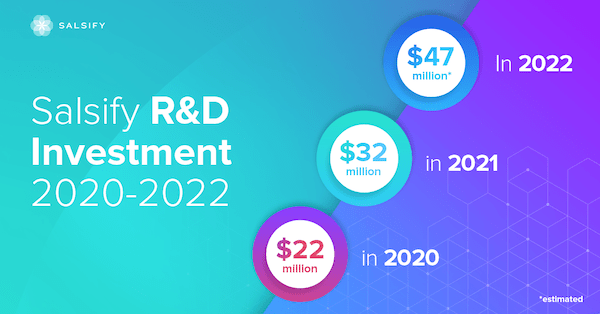Ecommerce is undergoing exponential growth. Already on the rise pre-pandemic, the last two years have pushed this buying and selling approach into overdrive: Recent predictions noted by Forbes suggest that global ecommerce sales volumes will soon hit $4.2 trillion.
And it doesn’t stop there.
Along with spending more money online, customers are also more willing to share their data. Survey data from Merkle notes that 77% of customers are now willing to share personal information with brands in exchange for more personalized experiences.
Known as ecommerce personalization, it’s now a critical facet of digital customer service.
But how does ecommerce personalization work in practice? How does it benefit your businesses, and how can you effectively implement this approach?
What Is Ecommerce Personalization?
Ecommerce personalization is the use of customer-supplied data to create personalized online shopping experiences. These experiences may include customized ecommerce storefronts or product pages along with emails, newsletters, and social platform messaging that include personalized deals or discounts, curated product suggestions, or early access to new products.
How To Achieve Effective Ecommerce Personalization
To achieve effective ecommerce personalization, you must:
- Collect key data such as customer demographics, browsing habits, purchase histories, and preferred device usage; and
- Leverage this data to create a personalized profile that informs ongoing sales and marketing campaigns.
How Does Personalization Benefit Your Business?
Ecommerce personalization offers three key benefits for your business:
Improved Engagement
According to McKinsey & Company, “consumers now view personalization as the default standard for engagement.”
In other words, if content isn’t personalized to a consumer’s needs, chances are they’ll take their business elsewhere. And even if they do stick around, they’re less likely to interact with your brand across social and email channels, in turn reducing the chances of a successful conversion.
Increased Sales
Not surprisingly, effective ecommerce personalization drives increased sales. Consider a customer who visits your site and agrees to share data. If your marketing team uses that data to create a personalized profile and then send customer-specific offers or discounts for preferred products directly to the consumer, they can shorten the distance between lead generation, engagement, and conversion.
Reduced Customer Churn
Also according to Merkle, 88% of consumers perceive a brand’s products as having higher quality if they feel like the brand is listening to their needs. This provides an opportunity to reduce customer churn.
With businesses of all types and sizes now making the move to online sales and buy online, pick up in store (BOPIS) options, companies need to stand out from the crowd by making it clear that they’re interested in meeting customers where they are — not where they’d like them to be. Personalization makes this possible.
Worth noting? Ecommerce impacts aren’t uniform worldwide. While PwC reports that 63% of U.S. consumers are more open to sharing their data for a product or service they truly value, the numbers are lower in Europe, according to Consultancy.eu.
The UK leads the way with 29% of customers willing to share their data, with countries like France and Sweden coming in slightly lower at 26% and 22%, respectively. Germany and Finland, meanwhile, round out the bottom of the pack with just 15% of Germans and 8% of Finns willing to share their data.
These findings speak to the need for personalization programs capable of aligning with local conditions to meet customer expectations around data sharing, marketing communication, and product preferences.
What’s Required for Effective Ecommerce Personalization Implementation?
Of course, it’s not enough to simply recognize the need for improved personalization — companies must implement best practices that underpin the effective collection, curation, and connection of this data to actionable outcomes. In practice, these include:
Comprehensive Data Collection Strategies
Ecommerce personalization starts with data collection. As a result, it’s critical for companies to develop comprehensive strategies that include clear communication about what data is being collected, how it’s being used, and how customers can revoke consent at any time.
Ongoing Evaluation
Next, retailers must recognize the dynamic nature of ecommerce behavior. From broad analysis to more in-depth evaluation of audience preferences, ongoing efforts are required to stay ahead of emerging trends.
Omnichannel Implementation
Customers now expect brands to be reachable across any channel at any time. As a result, ecommerce personalization means creating an omnichannel framework that empowers customers to get in touch on their timeline — and uses data to ensure their time isn’t wasted when they connect with an agent.
Customized Product Pages
The final step before a sale? Your product page. Just like everything else in a personalized ecommerce approach, these pages should be tailored to consumer expectations. This might mean showing customers a curated selection of products they might like based on their preferences, or it could mean allowing them to customize purchases directly from product pages to get exactly what they want.
This Time, It’s Personal: Realizing the Benefits of Ecommerce Personalization
Effective ecommerce strategies are now essential for companies to succeed in a digital-first market. But better websites and streamlined storefronts only go so far. To stay competitive, retailers must connect with customers where they are by creating customized, personalized experiences that improve engagement, encourage connection, and drive conversion.
Ready to make the most of expanding ecommerce markets with improved customer personalization? Start with Salsify’s “Complete Product Page Toolkit.”



![How to Start an Online Business in 2022 [8 Steps for Success]](https://thegateway.net.au/wp-content/uploads/2022/10/how-to-start-an-online-business-in-2022-8-steps-for-success-768x402.png)



